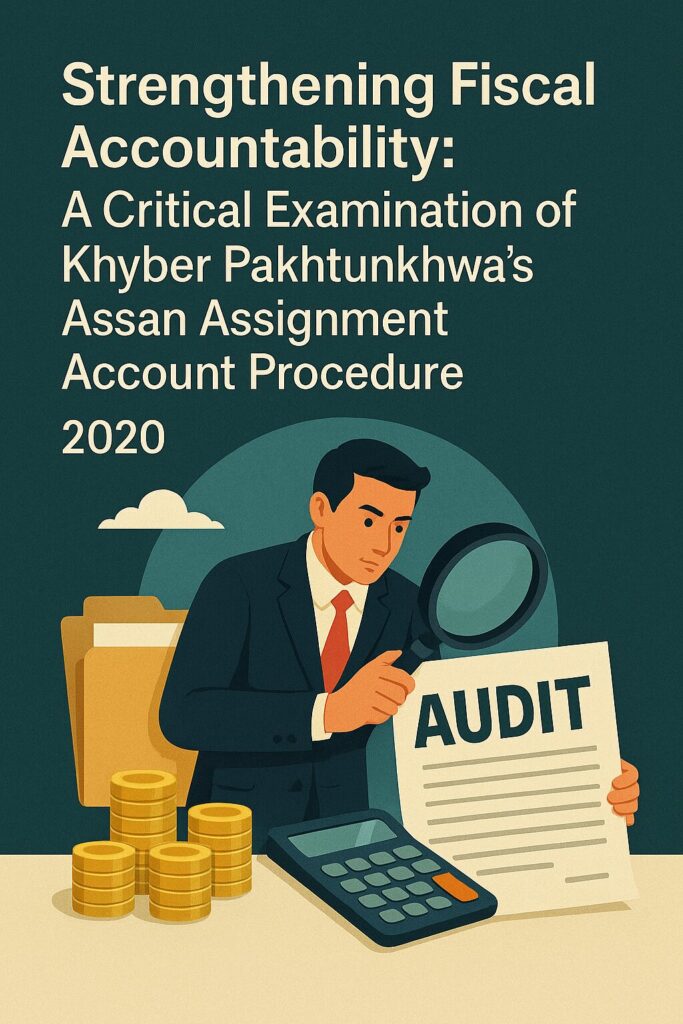
Introduction:
The Khyber Pakhtunkhwa (KP) government’s *Assan Assignment Account Procedure (Local Currency), 2020* represents a significant step toward aligning provincial fiscal management with national frameworks like the Public Finance Management Act (PFMA) 2019 and the Treasury Single Account (TSA) system. Designed to streamline the operation of Assignment Accounts for development and non-development expenditures, the procedure aims to enhance transparency, reduce fragmentation, and ensure compliance with modern financial regulations. However, while the document lays a robust foundation, it also reveals systemic bottlenecks and gaps that could hinder its effectiveness. This article critically analyzes the procedure’s key provisions, identifies shortcomings, and offers actionable recommendations for improvement.
Overview of the Procedure:
The 20-page document outlines a structured framework for managing Assignment Accounts, which are now integrated into the Provincial Consolidated Fund. Key features include:
1. Role of Principal Accounting Officers (PAOs): PAOs hold exclusive authority to open/close accounts, approve signatories (BS-17 officers or above), and ensure compliance with financial rules.
2. Banking Mandate: Accounts must be opened exclusively in designated National Bank of Pakistan (NBP) branches, with strict prohibitions on cash withdrawals and fund transfers.
3. Automation Push: NBP is mandated to automate processes by December 2020, phasing out manual payments.
4. Sub-Assignment Accounts: Allow decentralized expenditure management for projects spanning multiple locations.
5. Surrender of Funds: Unspent balances at fiscal year-end lapse unless surrendered.
Key Shortcomings:
1. Bureaucratic Complexity:
The procedure involves multiple layers of approvals—PAOs, Finance Division, CGA, and NBP—for routine tasks like changing signatories or opening sub-accounts. For instance, Clause 2(vi) requires PAO approval for signatory changes even in temporary vacancies, creating delays. Smaller projects lacking BS-17 officers face additional hurdles, relying on ad-hoc solutions (Clause 1(v)).
2. Reliance on Manual Processes:
Despite mandating automation, the procedure permits manual payments post-2020 with Finance Division approval (Clause 3(vii)). This loophole risks perpetuating inefficiencies and undermines the automation drive.
3. Rigid Banking Infrastructure:
Restricting accounts to NBP branches limits competition and accessibility, especially in remote areas. While NBP’s dominance ensures uniformity, it ignores potential benefits of involving other scheduled banks under similar guidelines.
4. Inflexible Fund Management:
The mandatory surrender of unspent balances (Clause 1(i)) discourages long-term financial planning. Multi-year projects, particularly in development sectors, suffer as funds cannot be carried forward, leading to rushed expenditures.
5. Ambiguities in Compliance:
While monthly reconciliation is required (Clause 2(vii)), the document lacks enforcement mechanisms. There are no penalties for non-compliance, risking inconsistent reporting.
6. Inadequate Training Provisions :
The procedure assumes familiarity with complex financial rules but does not mandate training for PAOs or signatories, increasing the likelihood of procedural lapses.
Recommendations for Improvement:
1. Streamline Approvals Through Digitization:
Introduce a centralized digital portal for PAOs to approve signatory changes, account openings, and fund allocations. This would reduce delays and minimize paperwork.
2. Eliminate Manual Payment Exceptions:
Enforce a hard deadline for full automation, removing provisions for manual approvals. Integrate real-time payment tracking to ensure compliance.
3. Expand Banking Options:
Permit Assignment Accounts in other scheduled banks adhering to State Bank of Pakistan (SBP) guidelines. This would enhance accessibility and foster competitive service quality.
4. Introduce Partial Carry-Forward Mechanisms:
Allow projects to retain a percentage (e.g., 20%) of unspent funds for the next fiscal year, subject to PAO approval. This incentivizes prudent spending without compromising accountability.
5. Strengthen Compliance Mechanisms:
Implement automated alerts for reconciliation deadlines and impose penalties (e.g., fund freezes) for delays. Publish quarterly compliance reports to promote transparency.
6. Mandate Training Programs:
Develop mandatory workshops for PAOs and signatories on PFMA rules, digital tools, and anti-fraud measures. Partner with institutions like the National School of Public Policy to deliver curricula.
7. Clarify Foreign Currency Guidelines:
Include a brief annexure referencing Foreign Currency Assignment Account rules, reducing ambiguity for cross-border projects.
The Assan Assignment Account Procedure 2020 is a commendable effort to modernize KP’s fiscal governance. However, its effectiveness hinges on addressing bureaucratic inertia, enhancing flexibility, and leveraging technology. By adopting the recommendations above, the province can transform this framework into a dynamic tool for efficient public financial management, setting a benchmark for other regions. As KP navigates post-devolution challenges, prioritizing both accountability and adaptability will be key to achieving sustainable development goals.
